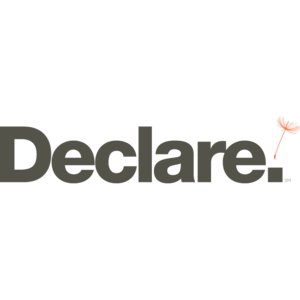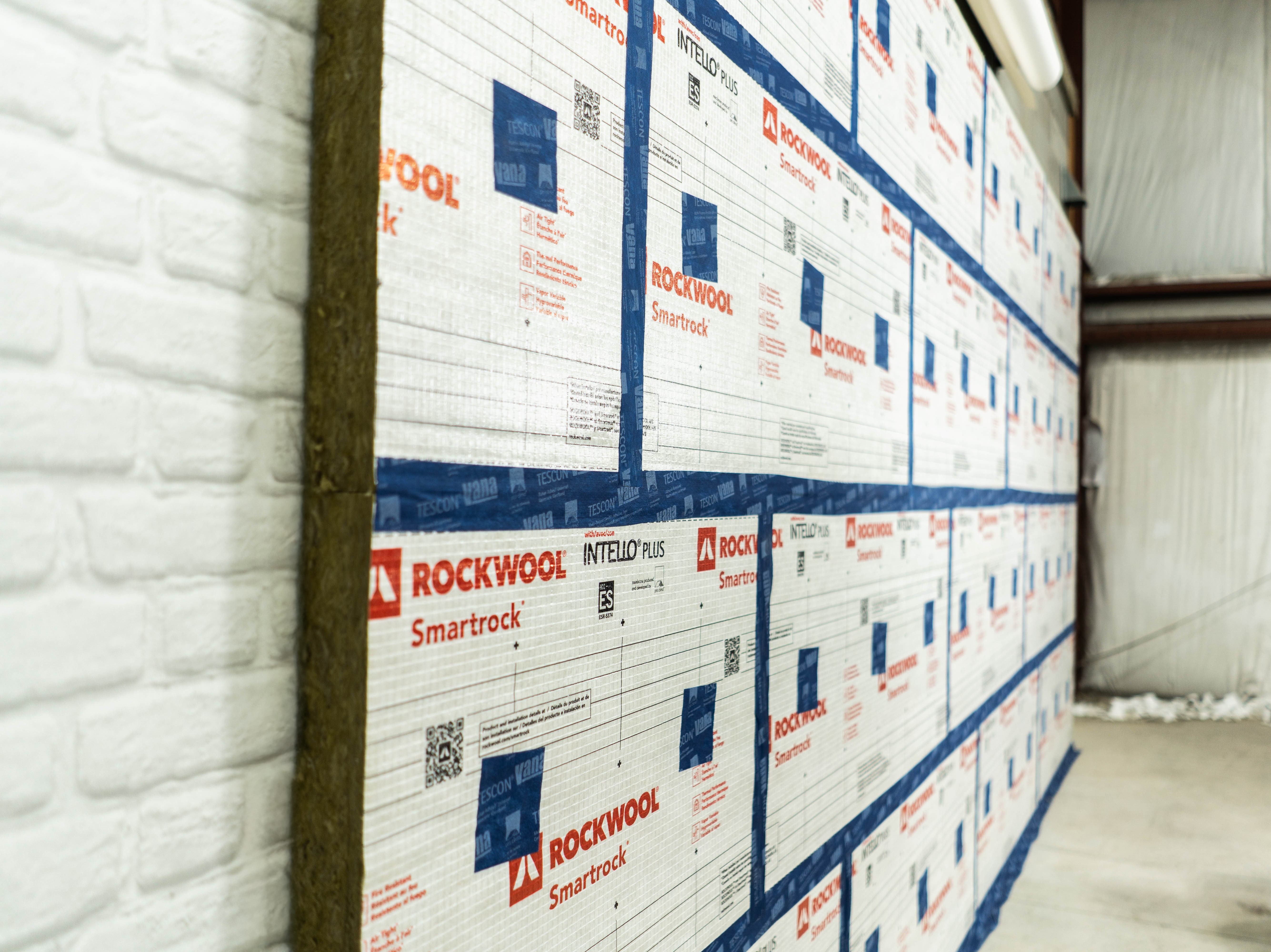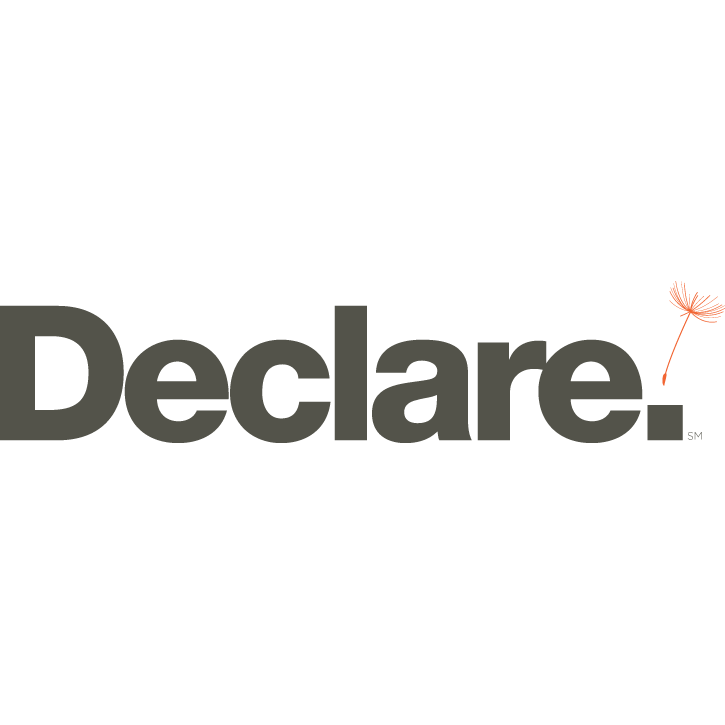Smartrock®
ROCKWOOL Smartrock® is a stone wool insulation board with an integrated smart vapor retarder, or humidity-dependent vapor retarder, for continuous insulation on the interior of concrete and masonry wall assemblies.
1/2
Popular applications
- Exterior wall insulation
- Interior-insulated mass wall
About Smartrock®
ROCKWOOL Smartrock® is a stone wool insulation board designed for use as continuous insulation on the interior side of concrete and masonry exterior wall assemblies.
This innovative product utilizes INTELLO® PLUS by Pro Clima as an integrated smart vapor retarder, allowing Smartrock to adapt to changing humidity conditions, while also creating an airtight layer when properly sealed. Smartrock is noncombustible, and achieves a Class A fire rating for flame spread and smoke development.
Smartrock is available in 24" x 48" boards sizes, with thicknesses from 2" to 5" in half inch increments.
Smartrock is available in select regions of the USA. Connect with your local ROCKWOOL representative for more information.
- Noncombustible and fire resistant
- Consistent Thermal Control
- Smart Vapor Control
- Airtight assembly
- Efficient Installation
Why use stone wool insulation
- Provides stable, long-term thermal performance, even with changes in temperature
- Integrated smart vapor retarder to control vapor movement through the assembly, allowing the substrate to dry in both directions
- The integrated membrane provides an airtight layer when installed with proper sealing of insulation joists, fasteners, and other penetrations
- Smartrock is a Class A fire rated material in accordance with ASTM E84, and is classified as a noncombustible material in accordance with IBC Section 703.3.1.
- Smartrock offer fast and straightforward installation with only standard construction tools required, such as drills and hammers
Applications
- Interior-insulated concrete and masonry exterior walls.
- Ideal for projects in climate zones 4 and above requiring interior vapor control.
- Energy retrofits where existing cladding must remain, such as historic renovations.
- Effective for new construction with prefab concrete or masonry.
Product certificates
 Declare
Declare ICC-ES ESR-5374
ICC-ES ESR-5374
Specifications & testing
Explore Smartrock® specifications and test results, based on relevant industry standards.
| Name | Value | Unit | Test standard |
|---|---|---|---|
| Mineral Fiber Block and Board Thermal Insulation | Type IVB Compliant | ASTM C612 | |
| Flame spread index | 15 | ASTM E84 | |
| Smoke Developed Index | 20 | ASTM E84 | |
| Combustibility of Materials at 750 °C | Non-combustible | ASTM E136 | |
| Corrosion of Steel | Passed | ASTM C665 | |
| R-Value / inch @ 75 °F | 4.2 | hr.ft².F/Btu | ASTM C518 (C177) |
| RSI value / 25.4 mm @ 24 °C | 0.74 | m²K/W | ASTM C518 (C177) |
| Determination of Fungi Resistance | Passed | ASTM C1338 |
Smartrock® technical documents & resources
Download Smartrock® technical documents and resources, including the product data sheet, to support accurate specification and efficient project planning.

Smartrock technical data sheet
Smartrock is noncombustible, Class A-rated, and its membrane enhances airtightness and efficiency.

Smartrock features and benefits fact sheet
ROCKWOOL Smartrock interior continuous insulation for mass walls features and benefits

ROCKWOOL Smartrock Frequently Asked Questions

Smartrock installation instructions in masonry wall construction
This document provides ROCKWOOL Smartrock installation instructions, requiring professional assessment for project suitability.

SMARTROCK - 072113 GUIDESPEC - US-EN
Smartrock FAQ
ROCKWOOL Smartrock boards consist of a humidity-dependent vapor retarder, ProClima INTELLO Plus®, laminated to the surface of a semi-rigid stone wool insulation board compliant with ASTM C612. The INTELLO Plus® membrane, which meets the ICC-ES Acceptance Criteria for Humidity-Dependent Vapor Retarders (AC538), is composed of a polypropylene nonwoven fabric, a vapor-variable polyethylene copolymer membrane, and a polypropylene microfiber fleece cover.
A smart vapor retarder—also known as a smart membrane or humidity-dependent vapor retarder—is a vapor control layer whose permeability adjusts in response to changes in the surrounding relative humidity. Under higher indoor humidity conditions, such as during the heating season in winter, it acts as a low Class II vapor retarder (greater than 0.1 and up to 1.0 perm), effectively controlling vapor diffusion through the wall assembly. When indoor humidity decreases, as in the cooling season during summer, the material’s vapor permeability increases, allowing it to function as a Class III vapor retarder (greater than 1.0 and up to 10 perms). This higher permeability enables moisture within the wall to dry out toward the interior, reducing the risk of moisture accumulation within the wall.
Smartrock is particularly well suited for retrofitting masonry or concrete walls in scenarios where the application of exterior insulation is impractical due to zoning restrictions, aesthetic considerations, or property boundaries. However, it is critical to recognize that insulating mass walls in cold climates—especially those that are both cold and wet—can introduce significant performance and durability challenges if moisture management is not properly addressed.
The key advantage of Smartrock is its integrated, laminated, humidity-dependent vapor retarder. This smart membrane dynamically adjusts its permeability in response to ambient moisture conditions. During the heating season, it restricts outward vapor diffusion, thereby reducing the risk of condensation on the interior face of the masonry. When vapor drive reverses (i.e., from exterior to interior), the membrane becomes more permeable, enabling inward drying and supporting effective moisture management as well as long-term durability of the wall assembly.
Smartrock is also classified as noncombustible in accordance with ASTM E136 and as Class A, with a flame spread index of 0 and a smoke developed index of 0, when tested in accordance with ASTM E84. These properties make it an optimal choice for enhancing fire resistance in legacy buildings without compromising safety. Furthermore, as documented in ICC-ES ESR-5374, Smartrock has been evaluated for compliance with the 2012, 2015, 2018, 2021, and 2024 editions of the International Building Code (IBC), International Residential Code (IRC), and International Energy Conservation Code (IECC).
In addition, the product’s lower-density bottom layer enables it to conform effectively to irregular or uneven substrates, facilitating installation on historic masonry or stone surfaces. Its semi-rigid composition allows for straightforward removal, making Smartrock especially advantageous for heritage retrofit projects where reversibility and minimal intervention are essential preservation requirements.
Yes, Smartrock is well-suited for below-grade applications, as interior continuous insulation on concrete or masonry foundation walls. It is an excellent choice for basements and partially below-grade walls where continuous insulation is required to meet energy codes such as the IECC. Smartrock’s humidity-dependent vapor resistance facilitates moisture diffusion and helps prevent condensation in wall assemblies that must dry inward—an important benefit for basements with exterior waterproofing.
The INTELLO Plus® membrane has limited resistance to ultraviolet (UV) radiation and should not be left exposed to sunlight. Extended UV exposure can deteriorate the membrane, reducing its performance and potentially compromising its long-term integrity.
Smartrock is typically installed during the interior finishing stage of construction, before framing and the application of interior drywall or other finishes. In new construction, this involves installing Smartrock once the supporting mass wall has been fully erected and appropriately prepared. For retrofit projects, installation should occur only after removing any existing interior furring, lath, or plaster to fully expose the masonry substrate from the interior. This approach is essential, as materials like gypsum are moisture-sensitive, and retaining old layers can create voids that may cause unintended air leakage and compromise the building envelope.
Before installing Smartrock, a fluid-applied, vapor-permeable air and water-resistive barrier should be applied to the back of the mass wall. This barrier serves as the primary air barrier, prevents localized water leakage from penetrating and collecting at floor levels, and allows moisture vapor to move in both directions, supporting effective moisture management.
While the addition of batt insulation between interior studs may enhance thermal performance, it is generally not recommended in wall assemblies that already feature Smartrock as interior continuous insulation.
Adding insulation inboard of the smart membrane alters the temperature gradient and relative humidity profile within the wall, which can cause the vapor permeance of the membrane to respond in ways that may not be optimal. This can increase the risk of moisture accumulation or related issues within the assembly. The suitability of this approach should always be evaluated based on project-specific conditions.

Attend a ROCKonnect Masterclass
Earn CEUs and gain expert insights into high-performance building envelope design—all in a live virtual format built for commercial building professionals. Learn from award-winning experts and apply real-world solutions to your next project.





